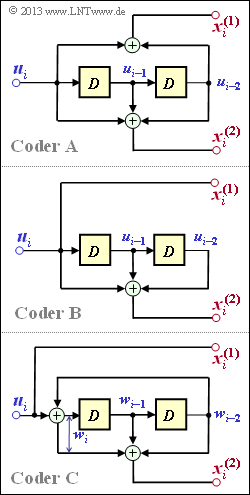Aufgaben:Aufgabe 3.4: Systematische Faltungscodes: Unterschied zwischen den Versionen
| Zeile 30: | Zeile 30: | ||
===Fragebogen=== | ===Fragebogen=== | ||
<quiz display=simple> | <quiz display=simple> | ||
| − | { | + | {Wie lautet die Übertragungsfunktionsmatrix von <b>Coder A</b>? |
|type="[]"} | |type="[]"} | ||
| − | + | + | + $\mathbf{G}(D) = (1 + D^2, \ 1 + D + D^2)$, |
| − | - | + | - $\mathbf{G}(D) = (1 + D + D^2, \ 1 + D^2)$, |
| + | - $\mathbf{G}(D) = (1, \ 1 + D + D^2)$. | ||
| − | { | + | {Wie lautet die äquivalente systematische Übertragungsfunktionsmatrix? |
| − | |type="{} | + | |type="[]"} |
| − | $ | + | - $\mathbf{G}_{\rm sys}(D) = (1 + D + D^2, \ 1 + D^2)$, |
| + | - $\mathbf{G}_{\rm sys}(D) = (1, \ 1 + D + D^2)$, | ||
| + | - $\mathbf{G}_{\rm sys}(D) = (1, \ (1 + D + D^2)/(1 + D^2))$. | ||
| + | |||
| + | {Welcher Coder ist zu Coder A äquivalent und systematisch? | ||
| + | |type="[]"} | ||
| + | - <b>Coder B</b>, | ||
| + | + <b>Coder C</b>. | ||
</quiz> | </quiz> | ||
Version vom 30. November 2017, 11:13 Uhr
Man spricht von einem systematischen Faltungscode der Rate $R = 1/2$ ⇒ $k = 1, \ n = 2$, wenn das Codebit $x_i^{(1)}$ gleich dem momentan anliegenden Informationsbit $u_i$ ist.
Die Übertragungsfunktionsmatrix eines solchen Codes lautet:
- $${\boldsymbol{\rm G}}(D) = \big ( \hspace{0.05cm} 1\hspace{0.05cm} , \hspace{0.2cm} G^{(2)}(D) \hspace{0.05cm}\big ) \hspace{0.05cm}.$$
Der in der oberen Grafik dargestellte Coder A ist sicher nicht systematisch, da für diesen $G^{(1)}(D) ≠ 1$ gilt. Zur Herleitung der Matrix $\mathbf{G}(D)$ verweisen wir auf ein früheres Beispiel, in dem für unseren Standard–Rate–1/2–Coder mit Gedächtnis $m = 2$ ermittelt wurde:
- $${\boldsymbol{\rm G}}(D) \hspace{-0.15cm} \ = \ \hspace{-0.15cm} \big ( \hspace{0.05cm} G^{(1)}(D)\hspace{0.05cm} , \hspace{0.2cm} G^{(2)}(D) \hspace{0.05cm}\big ) =$$
- $$ \ = \ \hspace{-0.15cm} \big ( \hspace{0.05cm} 1 + D + D^2\hspace{0.05cm} , \hspace{0.2cm} 1 + D^2 \hspace{0.05cm}\big ) \hspace{0.05cm}.$$
Der Coder A unterscheidet sich gegenüber diesem Beispiel nur durch Vertauschen der beiden Ausgänge. Lautet die Übertragungsfunktionsmatrix eines Codes
- $${\boldsymbol{\rm G}}(D) = \big ( \hspace{0.05cm} G^{(1)}(D)\hspace{0.05cm} , \hspace{0.2cm} G^{(2)}(D) \hspace{0.05cm}\big ) \hspace{0.05cm},$$
so gilt für die äquivalente systematische Repräsentation dieses Rate–1/2–Faltungscodes allgemein:
- $${\boldsymbol{\rm G}}_{\rm sys}(D) = \big ( \hspace{0.05cm} 1\hspace{0.05cm} , \hspace{0.2cm} {G^{(2)}(D)}/{G^{(1)}(D)} \hspace{0.05cm}\big ) \hspace{0.05cm}.$$
In der Teilaufgabe (3) ist zu prüfen, welcher der systematischen Anordnungen (entweder Code B oder Code C oder auch beide) äquivalent zum Code A ist.
Hinweis:
- Die Aufgabe bezieht sich auf die Thematik von Kapitel 3.2.
Fragebogen
Musterlösung
